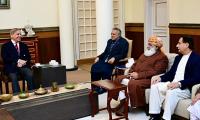The Covid-19 pandemic has the potential to infect 40-70 percent of the world’s population. By this date, more than 1300 people have been confirmed infected in Pakistan, resulting in eleven deaths. The number of expected infections is feared to increase manifolds in the coming days.
Anyone can be exposed to the virus, but the poor are the most vulnerable because they do not have the means to cope on their own. The recession, which is most probable to follow this outbreak, is expected to affect the economically vulnerable group the most. Poor workers, especially those dependent on a daily wage with no reserves, will not be able to cope with any possible lockdown as a response to the pandemic.
We have to evaluate the economic cost of this pandemic from the vulnerable group’s perspective and propose policy options to minimize its impact.
The official statistics provided by the Pakistan Bureau of Statistics (PBS) show that: the share of vulnerable employment is around 56 percent (52 percent among men and 71 percent among women). Vulnerable employment is measured as the proportion of own-account workers (also including the daily wage earners) and unpaid family workers in total employment.
As for sectoral share of vulnerable employment, it is more than 80 percent in agriculture; about three-fourths in wholesale and retail trade; near 50 percent in hotel and restaurants; more than three-fifths in real estate and business; and approximately two-fifths in transport and communication sector.
In the given scenario, Covid-19 poses huge implications for the poor and vulnerable segments of society. It will substantially increase poverty levels across the country. To make things worse, our health system is not designed to deal with such outbreaks and that too at this severity level.
Due to the likely economic recession and vulnerability of the employed in the country, Covid-19 may lead to significant increase in poverty and unemployment. We consider three GDP growth scenarios to map poverty and unemployment. One, high impact [0 to 1.5 percent GDP growth – massive economic recession]. Two, medium impact [from 1.5 to 2.5 percent GDP growth – almost half of the projected GDP growth]. And, three, low impact [from 2.5 percent to 3.5 percent GDP growth – mild recession in the economy). Based on these scenarios, unemployment will increase by 0.21 million (low impact scenario) to 0.62 million (high impact scenario) from a base of 3.86 million in 2019. Total unemployment ranges from 4.07 million (low impact scenario) to 4.48 million (high impact scenario).
Due to Covid-19, it is projected that the poverty rate will increase from 23.4 percent (baseline poverty) to 33.7 percent (in case of a low-impact scenario) followed by 44.2 percent (in case of a medium-impact scenario) and 58.6 percent (in case of a high-impact scenario). Apart from the poor, a bulk of population share (around 19 percent) falls in the category of vulnerable groups – income just above the poverty line. Longer economic recession would push these people into poverty.
Based on these poverty rates, it is projected that poverty will increase by 20 million people (low impact scenario) to 70 million people (high impact scenario) from a base of 54 million people. The number of poor could, thus, increase from 75 million people to 125 million people, depending on the depth of the economic recession due to Covid-19.
Strengthen the safety net: Vulnerable workers are most likely to lose their jobs if they miss work. In the current scenario, their nature of job makes them least able to work remotely to avoid contracting the virus. They are also least likely to have savings to survive an economic downturn. Under such circumstances, safety nets, especially cash transfers, paid leaves, and health insurance, can provide quick financial support to overcome basic needs of vulnerable and poor segments of the society.
Scale up BISP: Double the cash transfer rate for the next three months with increased enrollment by raising the cutoff score from 16.17 to 25. There are already Rs180 billion rupees parked in BISP for this year with low utilization. So, the additional burden will be adjusted there. Some specific recommendations:
Increase the cash assistance to 8000 (half of the basic income) for the next three quarters for the already enrolled BISP beneficiaries. Include an additional 5.5 million families along with existing 4.5 million families. Additional beneficiaries could be included using the National Socio-Economic Registry (NSER 2011-12), the census data used by BISP for targeting purposes, by increasing the PMT up to 25 score.
Apart from these families, BISP with the help of NADRA using mobile contacts may also allow poor families to get cash assistance even if they are not included in the NSER. Global think-tanks also propose similar approaches to provide urgent support to the vulnerable and poor segments of the society. With the help of mobile companies and NADRA, BISP can target these families very quickly and disburse mobile money. BISP can use BISP Beneficiary Committees (BBCs) to spread information about new enrollment and precautionary measures to minimize the spread of COVID-19.
Cost implications: We calculated the expected cost using two scenarios for adding 10 million families to the safety net, that is cover an additional 65 million people approximately (taking an average family size of 6.5 persons):
Scenario 1: An additional enrollment of 5.5 million families with the ongoing stipend amount of Rs5500 per quarter. The additional cost for one quarter under this scenario would be Rs30.25 billion.
Scenario 2: Increase the cash assistance to 8000 with an additional enrollment of 5.5 million families. The additional cost for one quarter under this scenario would be Rs55.25 billion
We believe that the additional cost of Rs55.25 billion could be managed from the existing BISP budget. BISP has excluded around one million families from the existing net which provides enough space for BISP to expand its coverage.
The writer is an associate professor at the Pakistan Institute of Development Economics (PIDE). Email: dr.iqbaln@gmail.com
Many people believe that in future, AI will play an even more significant role in their lives
In April 2024, three Chinese and one Belarusian company were sanctioned for exporting missile-enabling technology to...
Pakistan has second highest neonatal mortality in world; in education sector, country's 26 million kids are out of...
Key actors in global power politics are US, China, Russia, European Union, and emerging powers such as India and Brazil
Maulana Fazl manages to bring together factions that historically stand opposed
NASA says August 2024 set new monthly temperature record, capping Earth’s hottest summer since 1880







